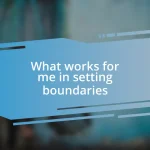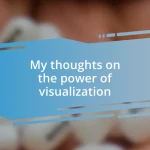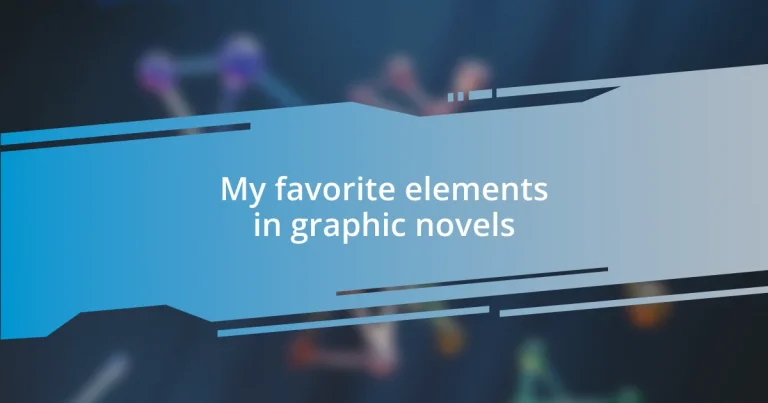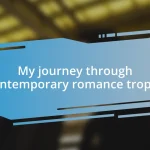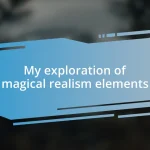Key takeaways:
- Graphic novels uniquely combine visuals and storytelling, enhancing emotional impact and making complex themes accessible.
- Visual storytelling techniques, such as panel layout and color palette, significantly influence narrative pacing and emotional atmosphere.
- Character development in graphic novels is enriched by visual evolution, supporting characters, and innovative narrative structures that deepen reader connections.
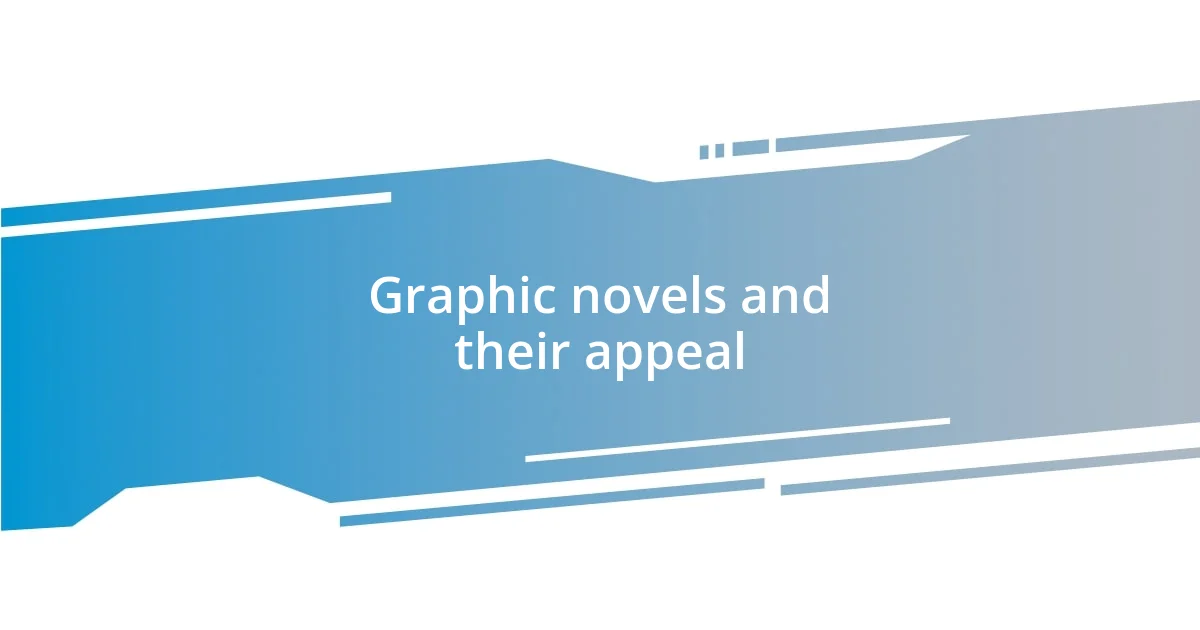
Graphic novels and their appeal
Graphic novels possess a unique charm that draws readers in, blending visual artistry with storytelling. I remember the first time I picked up Maus by Art Spiegelman—I was captivated by how the images complemented the narrative so beautifully. It made me wonder: how can a single panel evoke such powerful emotions? This interplay between visuals and text creates a reading experience that’s both immersive and dynamic.
The appeal of graphic novels lies in their ability to tackle complex themes in an accessible format. For instance, I was surprised by how Persepolis conveyed profound ideas about identity and culture through the simplistic yet striking artwork. It led me to appreciate how visuals can resonate in ways words alone sometimes can’t—how does this duality enhance our understanding of complex subjects?
Furthermore, there’s something incredibly engaging about the rhythm of graphic novel storytelling. The way panels flow from one to the next allows for a pacing that builds suspense and excitement. I often find myself racing through the pages, eager to see what happens next—doesn’t it feel exhilarating when a story unfolds like that, connecting moments in a way that feels almost cinematic?
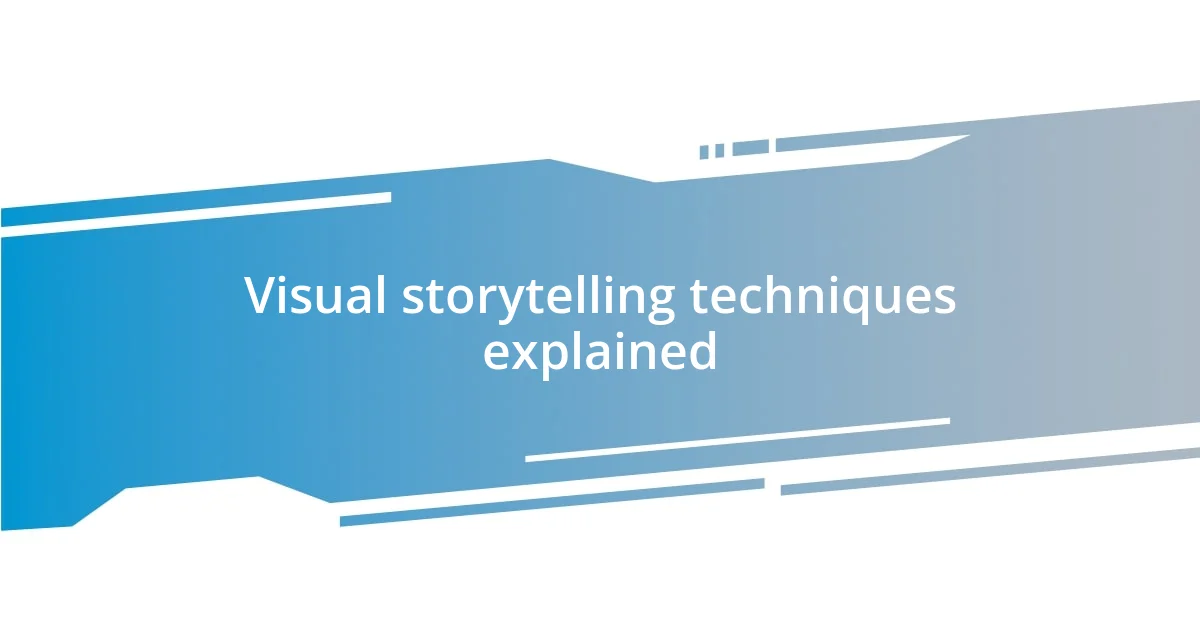
Visual storytelling techniques explained
Visual storytelling in graphic novels is a fascinating dance of imagery and narrative that captivates us at every turn. I distinctly recall reading Sandman by Neil Gaiman and being struck by how the illustrations not only complemented the storyline but often conveyed emotions and atmospheres that words could only suggest. The careful placement of panels guides the reader’s eye, creating a flow that feels organic, almost like breathing with the story itself.
Here are some key visual storytelling techniques that enhance a graphic novel’s impact:
- Panel Layout: The arrangement of panels can create tension or calm, guiding the reader’s pace through the story. For example, a crowded, chaotic layout can evoke urgency, while larger, open panels can instill a sense of tranquility.
- Color Palette: Colors dramatically affect the mood. When I read Saga, the vibrant colors painted a world of wonder, while muted hues in Watchmen spoke to its darker themes.
- Facial Expressions and Body Language: These elements can express subtle feelings. I often find myself drawn to the minute details in a character’s expression, which often convey feelings that dialogue might not capture.
- Symbolism: Visual symbols can deepen themes. For instance, in Bone, the recurring motif of the dreamlike landscapes highlights the characters’ journey, blending reality with imagination.
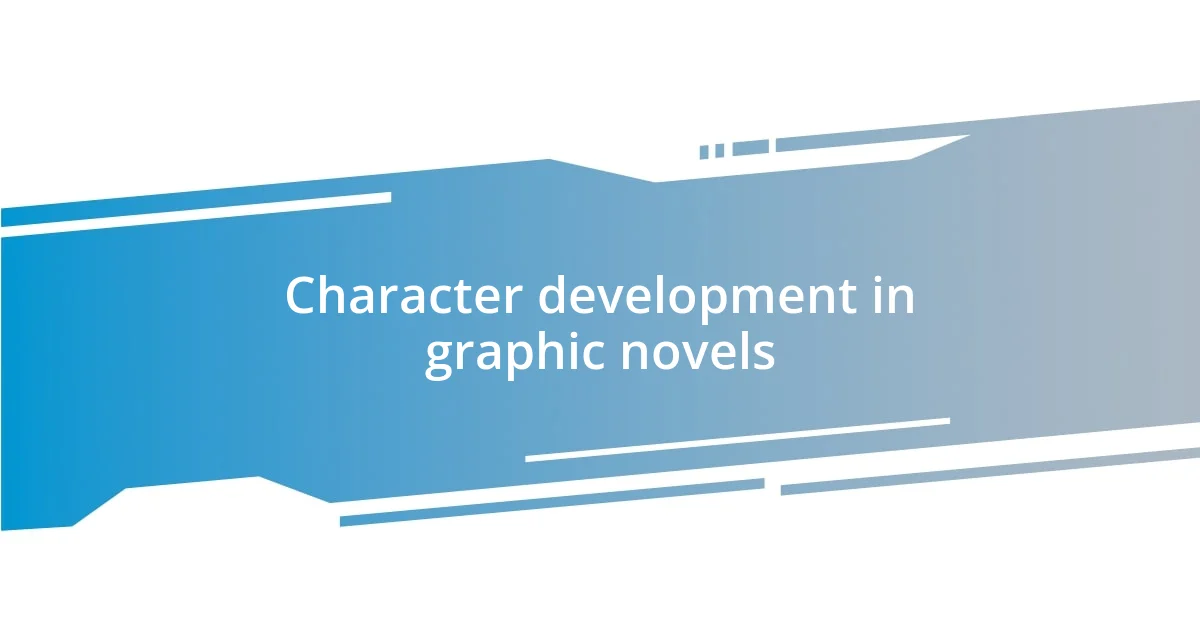
Character development in graphic novels
Character development in graphic novels truly stands out as a unique facet of the medium. I find it fascinating how some characters evolve visually alongside their emotional journeys. Take Y: The Last Man for example—Yorick’s transformation is not just in his actions but also reflected in how he is illustrated throughout the story. His changing expressions and postures subtly communicate his internal struggles and growth, almost like watching a silent actor on stage. Doesn’t it make you think about how much more can be conveyed through visuals than through words alone?
Another aspect that I deeply appreciate is the role of supporting characters in enriching the main character’s development. In Clyde Fans, the relationship between the brothers highlights their contrasting personalities, providing a fuller picture of each one’s psyche. The way supporting characters are drawn and portrayed often enhances the main narrative arc, allowing us to see different sides of the protagonist’s journey. It’s like seeing a character through a multifaceted lens—what about you? Have you ever noticed how secondary characters can shine a light on the hero’s flaws and strengths?
Lastly, narrative techniques play a critical role in character development. I recall feeling a rush of empathy while reading Fun Home, where Alison Bechdel employs flashbacks to explore her relationship with her father. These storytelling choices offer depth to characters, inviting us to understand their motivations from various angles. This layered approach often allows readers to build emotional connections that transcend the pages. I believe it’s this complex interplay of narrative and art that makes characters in graphic novels truly unforgettable.
| Aspect | Impact on Character Development |
|---|---|
| Visual Evolution | Characters’ growth is depicted through changing illustrations, emphasizing emotional transformation. |
| Supporting Characters | Enhance the protagonist’s journey by highlighting their strengths and weaknesses. |
| Narrative Techniques | Use of flashbacks and varying perspectives deepens our understanding of characters. |
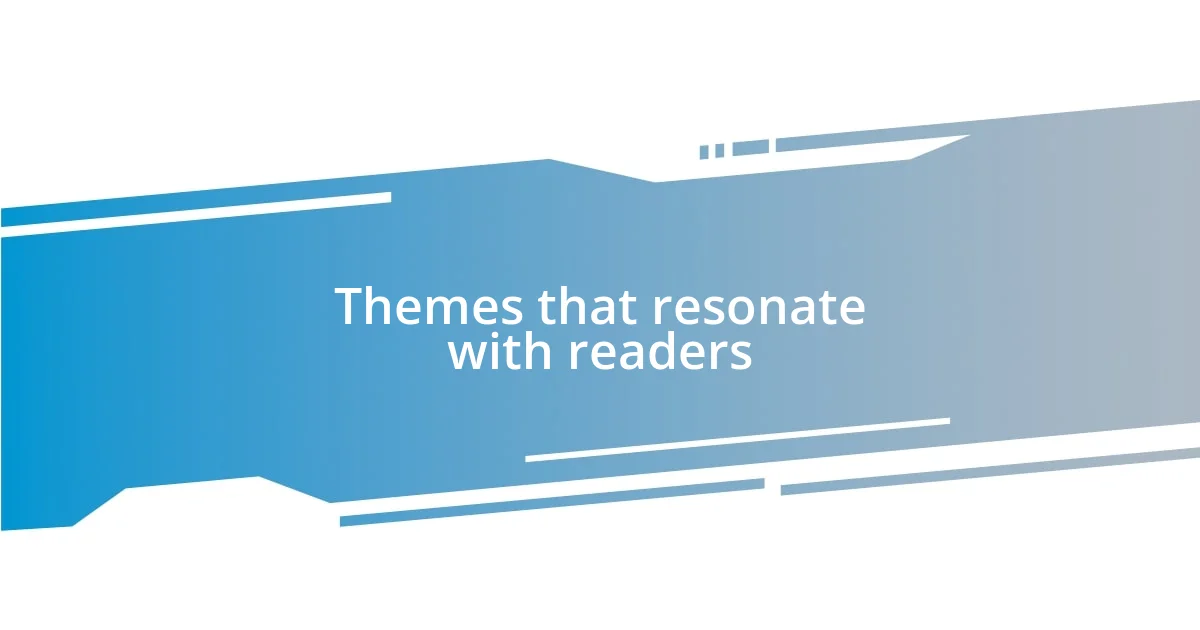
Themes that resonate with readers
Themes have a remarkable way of drawing us into the world of graphic novels, resonating with our personal experiences and emotions. For instance, I remember how the theme of isolation in Ghost World struck a chord with me during a particularly lonely period in my life. Clowes captures the struggle of feeling different and disconnected, reminding me that these feelings are universal. Isn’t it interesting how such themes can make us reflect on our own experiences, creating a powerful connection between the reader and the narrative?
Another theme that often captivates readers is the quest for identity, which I find incredibly relatable. In Ms. Marvel, Kamala Khan’s journey of self-discovery mirrors the struggles many face in figuring out who they are amidst societal pressures. I felt a sense of camaraderie with her as she navigated the ups and downs of adolescence, and it made me think—how often do we deny our true selves to fit in? This exploration of identity is a theme that resonates deeply and can inspire readers to embrace their own unique paths.
Of course, themes of love and loss are also prevalent, appearing in nearly every graphic novel I’ve read. When I flipped through Blankets by Craig Thompson, I was moved by his poignant exploration of first love and heartbreak. The emotions bleed off the pages, pulling at my own memories of young love, bittersweet and filled with hope and sadness. Have you ever read something that stirred up feelings you thought were long buried? That’s the power of these themes—they encapsulate the human experience in ways that are both profound and relatable.
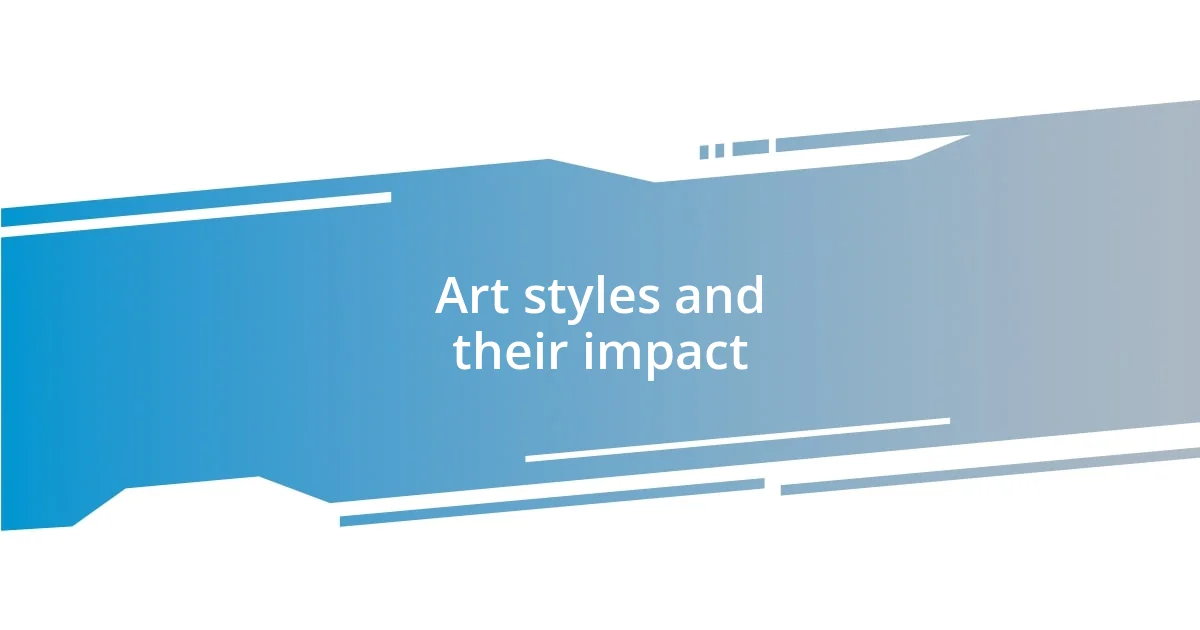
Art styles and their impact
Art styles in graphic novels are not merely decorative; they play a pivotal role in shaping the narrative and evoking emotion. I remember reading Sandman by Neil Gaiman, where the intricate and varied art styles reflect the dreamlike quality of the story. Each artist’s interpretation of characters and settings adds layers of meaning, making the surreal feel accessible. Isn’t it amazing how just a switch in visual style can shift your emotional response to a scene?
When an artist adopts a particular style, it often influences how we perceive the characters and their experiences. For instance, in Persepolis, Marjane Satrapi uses bold black-and-white illustrations to convey the gravity of her experiences growing up during the Iranian Revolution. This starkness serves to emphasize the seriousness of her narrative, allowing readers to feel the weight of her story. How does a certain style make you feel more connected to a character’s pain or joy?
Moreover, art styles can create distinctive atmospheres that enhance storytelling. Take Saga, for example, where Fiona Staples’ colorful and whimsical art juxtaposes the chaos of its plot. The vibrant hues invite readers into a world that is both fantastical and relatable, inviting laughter even amid conflict. I often find myself smiling page after page, reflecting on how the visuals not only complement but also elevate the story’s emotional impact. Doesn’t it make you wonder about the stories we might miss without the unique flair that art brings to graphic novels?
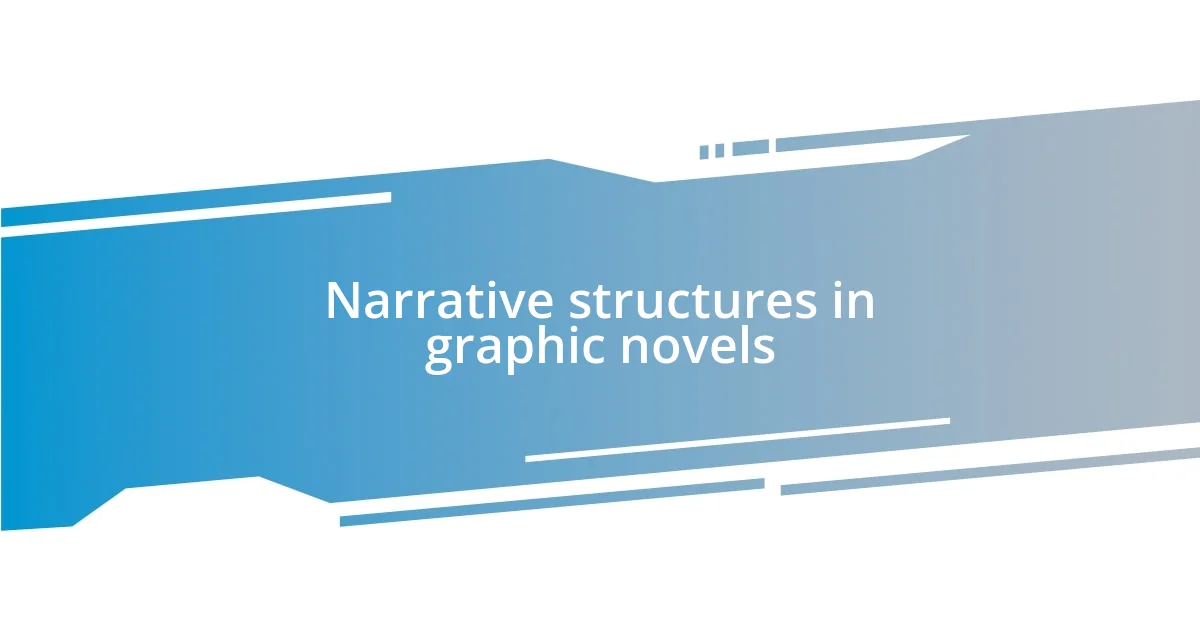
Narrative structures in graphic novels
Narrative structures in graphic novels can be incredibly innovative and multifaceted. I find it fascinating when a story utilizes non-linear timelines. For instance, in Watchmen, the intricate weaving of past and present narratives adds depth to character development and themes of morality. Have you ever noticed how this structure challenges the reader to piece together a puzzle, making the experience feel like a collaborative effort?
Another captivating narrative structure is the use of multiple perspectives. In Fun Home by Alison Bechdel, the story unfolds through various lenses, revealing the complexity of family dynamics. I remember feeling a whirlwind of emotions as each character’s voice added layers to the narrative, forcing me to confront my own biases and assumptions. Isn’t it powerful how a different viewpoint can completely shift your understanding of a situation?
Moreover, some graphic novels employ a very straightforward, linear structure, which can be just as compelling. In Bone by Jeff Smith, the seamless progression of the story allows readers to immerse themselves in a richly developed world without distractions. I felt an undeniable pull as I followed the characters’ journey, sometimes eager and sometimes anxious about what lay ahead. It makes me wonder—do you prefer a narrative that challenges you, or one that offers comfort and clarity? Each structure carries its own magic, inviting us, as readers, to engage in different ways.

Personal favorites and recommendations
When I reflect on my personal favorites in graphic novels, certain titles immediately come to mind. I can’t help but rave about Maus by Art Spiegelman. The way it intertwines personal history with broader themes of the Holocaust is nothing short of powerful. I remember the moment I first encountered the anthropomorphic animals representing different cultures—it struck me with such intensity. Have you ever read a story that changed the way you view history? That’s how I felt with Maus; it made the past feel palpable and haunting in a completely new way.
Another recommendation I can enthusiastically stand behind is Y: The Last Man by Brian K. Vaughan. I found the premise intriguing: a world where every male mammal perishes, except for one man and his pet monkey. This odd concept invites a deep exploration of gender dynamics and societal norms. What I loved most was the humor woven into so many dark themes—there were moments I laughed out loud, even amidst the tension. Have you ever paused to think how laughter can punctuate serious conversations? For me, this balance kept me on my toes, eager to see how the narrative would unfold.
Lastly, I’d be remiss not to mention Scott Pilgrim by Bryan Lee O’Malley. This one takes me right back to my late teens when I was immersed in indie music culture. The quirky art style and relatable struggles of Scott as he navigates love and adulthood resonated deeply with me. I can almost recall the feeling of camaraderie as I flipped through the pages, connecting with the characters’ relentless pursuit of their dreams amidst chaos. Don’t you love it when a story reflects your own experiences? It’s like finding a friend in printed form.

